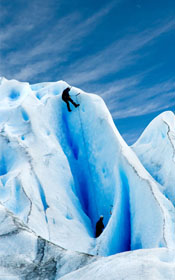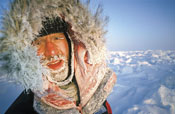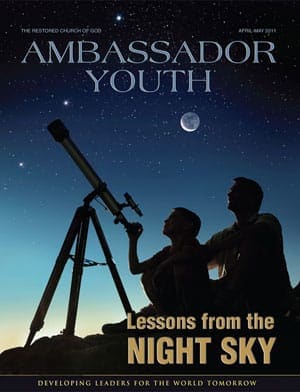Lifting your gaze from the ice crunching beneath your feet, you strain to see what lies ahead. The white snow appears murky. Blizzard conditions blind your eyes as you grasp at the details of the landscape ahead. Able to see only 10 feet from your headlamp, you continue trudging forward.
The sound of howling wind and cracking ice fills your ears. As you peer back at your footsteps, you tug the rope attached to your bullet-shaped supply sled. Even while moving across slippery ice, the 200-pound sled feels like an anchor.
It is the beginning of a polar winter in Antarctica.
The onset of the polar winter means you will not see the sun for at least another 30 days. The oppressive darkness makes you feel as though you are in a cave. It seems the flat ice field on which you walk has not changed elevation for miles.
As you brave the cold, you think about the many dangers that lie ahead. Thin ice can break at any moment and plunge the most careful explorer into icy waters. Snowdrifts often hide 40-foot-deep chasms. In addition, sleeping on ice is treacherous, since staying too long on a particular spot weakens it. Persistent blizzards have stranded many explorers who could not find shelter on a sturdy enough ice sheet.

Source: Canstockphoto.com
You look behind once again, watching for wandering polar bears. The largest land carnivore, polar bears grow up to 10 feet long and can weigh 1,500 pounds. With no natural predator, they become aggressive when hungry. You do not want to become just another tasty snack!
When traveling solo, polar travelers must carry everything they need from start to finish. A three-month expedition requires at least 300 pounds of equipment and food. On top of physical perils, long stretches of isolation and unending canvases of snowy landscape can wear down the minds of even the strongest individuals.
With the possibility of such danger, many wonder why people go to this type of extreme to test their endurance. Expeditions are often used to collect scientific data. Others raise money for charity. Once out in the frozen wilderness, however, the most successful polar explorers admit their real goal is to stretch their limits and see what they can accomplish in the harsh environment.
While each traveler is different, there are common traits that can be learned from their stories of triumph.
Icy Challenges
To complete a successful expedition, polar explorers must exercise determination, resourcefulness and the ability to rise after defeat. These traits allow them to push themselves harder and further in the foreboding darkness and unknown pitfalls of the frozen wilderness than they ever thought possible.
One of the most successful polar adventurers is Borge Ousland. A Norwegian-born explorer, he forged a name for himself by accomplishing many seemingly impossible solo trips across some of the iciest regions of the world.

Frozen frontiers: Borge Ousland, one of the foremost arctic explorers, has made several pioneer solo expeditions during his career.
Source: Courtesy of Borge Ousland
In his youth, Mr. Ousland did not appear destined for greatness. He was born to an average middle-class family who were active outdoors, but not explorers. During an interview with National Geographic, his mother commented, āThere really was no indication heād do this,ā and, āGrowing up, he was not as tough as he seems now.ā
Mr. Ousland had no formal education. He worked many different jobs through the years, and for a time served in the Norwegian Special Naval Services, a military branch similar to the American Navy SEALs.
The prospect of exploring oceans and crossing countries, however, always interested Mr. Ousland. Following in the footsteps of the first man to cross Greenland, Norwegian-born Fridtjof Nansen, Mr. Ousland began his career in polar exploration after crossing Greenland himself in 1986. This first trip sparked his love for the ice, and propelled him toward becoming the first man to successfully complete a series of pioneering solo expeditions. The first two expeditions were across the North Pole, in 1990 and 1994. Two years later, he crossed Antarctica.
One of his crowning achievements was an 82-day trek across the Arctic Ocean in 2001. During this solo journey, Mr. Ousland traveled 1,240 miles on foot, from Severnaya Zemlya, Russia to Ward Hunt Island, Canada.
When a National Geographic reporter questioned him about the motives for his trip, his reply was simple: āI want to see if itās possible. And I want to be the first to do it.ā
Top of the World
In 2006, Mr. Ousland and another accomplished polar explorer, Mike Horn, set out to conquer the frozen tundra together. It was a change for both, since they are mainly solo arctic explorers. For their trip, they decided to walk 620 miles from western Siberia to the North Pole.
The explorers began by covering 10 miles at the start of the polar night. This meant that for the first 30 days of the trip neither explorer would see or feel the warming rays of the sun. The trip lasted two months and was completely unsupportedāno airdrops of food or supplies, no dogsleds.
During the minus 25 Fahrenheit degree days, the men ate 6,500 caloriesāalmost three times the normal daily amount! They wore the same four layers of clothing for almost two months and brought only one change of underwear, socks and gloves.
A few of the challenges they faced included pressure ridges (or cracks in the surface of the ice) that were 25 feet high, hungry polar bears, deep crevasses, constant darkness, and, at times, temperatures of 80 degrees below zero Fahrenheit. Flesh exposed in this weather suffers frostbite quickly. Mr. Horn recalled an expedition in which he removed his gloves to fix a shoestring and within minutes experienced frostbite. As a result, he lost part of his thumb and the tips of three fingers.
While these conditions seem impossible to endure, the darkness was the most challenging aspect of the trip. No sunlight meant that wet clothing froze quickly and would not dry the entire trip. In such cold temperatures, the only heat is body heat. Unless an explorer keeps dry, his sweat turns against him, dampening his clothing and freezing them into solid ice.
Ingenuity and Endurance
Explorers must carefully plan before embarking on a trip or traveling alone in the polar wilderness. They often take up to a year training physically and fine-tuning their equipment.
During Mr. Ouslandās trip across the Arctic Sea, he developed and pioneered a waterproof suit to float across stretches of water where there was no land or ice bridge to cross. He also designed an early form of kite-skiing. By repurposing a parachute as a sail, he was able to propel himself on skis across flat ice planes, traversing great distances with little effort.
To scare off hungry polar bears, Mr. Ousland developed a special round of non-lethal ammunition for the. 44 magnum he uses while traveling. The force and noise of the shot turns back the hungriest of bears.
Without developing unique gear to face challenges on the ice, he could not have completed his expeditions.
On top of ingenuity, a polar explorer must be able to bounce back from defeat. On one failed attempt to cross Antarctica in 1996, Mr. Ousland became stranded about 800 miles into his trip and succumbed to frostbite on his thighs. Approximately 52 days into his expedition (halfway through), he had to send up an emergency flare for an airlift. The frostbitten area had become infected and he was forced to stop the trip to recover.
Undaunted, 11 months later, after intense training and regaining weight lost due to injuries, he set out on the same journey. This time, his training paid off and he was able to cover more ground per day than the first time.
At the outset of his original Antarctica trip, Mr. Ousland made a statement that best summed up his reasons for his first attempt (and later ones): āOnly by pushing beyond our limits can we really learn something new about ourselves.ā
Practice Makes Perfect
Sir Edmund Hillary, a New Zealand explorer famous for climbing Mt. Everest, met Borge Ousland in 1997. They quickly became friends, as both shared a love of the outdoors and an appreciation for nature, finding beauty in the harshest environments. Mr. Hillary even wrote a foreword in one of Mr. Ouslandās books: āHe [Borge Ousland] isnāt doing it for the money or even for gloryā¦He is not trying to defeat nature, but only himself.ā
In an article by National Geographic, the reporter asked Mr. Ousland if he knew what Sir Hillary meant. The magazine quoted the younger explorer as saying, āI am not trying to overcome myself. Iām more trying to overcome my fears. I want to broaden my experience as much as possible.ā
Lessons from the Ice
Polar explorers regularly face the most extreme circumstances in modern exploring. They are up against challenging mental and physical obstacles. The example of Borge Ousland proves that pushing yourself in difficult circumstances can yield great success.
Mr. Ousland knew he could do more than he thought. He used each expedition to prove it to himself. His drive in the face of all obstacles carried him through some of his toughest expeditions.
The accomplished polar explorer learned he could push himself harder. The experience and environment of each trip taught him something different, and added to the wealth of information he had gained from previous trips. He looked forward to experimenting with new gear and matching wits with whatever he faced on each trip.
The characteristics of determination, resourcefulness and drive that polar explorers employ to successfully complete expeditions and reach their goals can be applied to any endeavor. These same qualities can be built in each one of usāif we are willing to expand our horizons. When an obstacle seems as though it is too much to overcome, remember these traits and diligently apply them. You may be surprised at what you are capable of doing.
Ultimately, whether you succeed or fail, see every challenge as an opportunity to broaden your experience. Then, the next time an obstacle arises, you too will have more experience on which to rely. This will put you in a better position to succeed.
No matter what you do, strive to apply these same traits. You will enjoy the challenge and find you can do more than you ever thought possible!


















